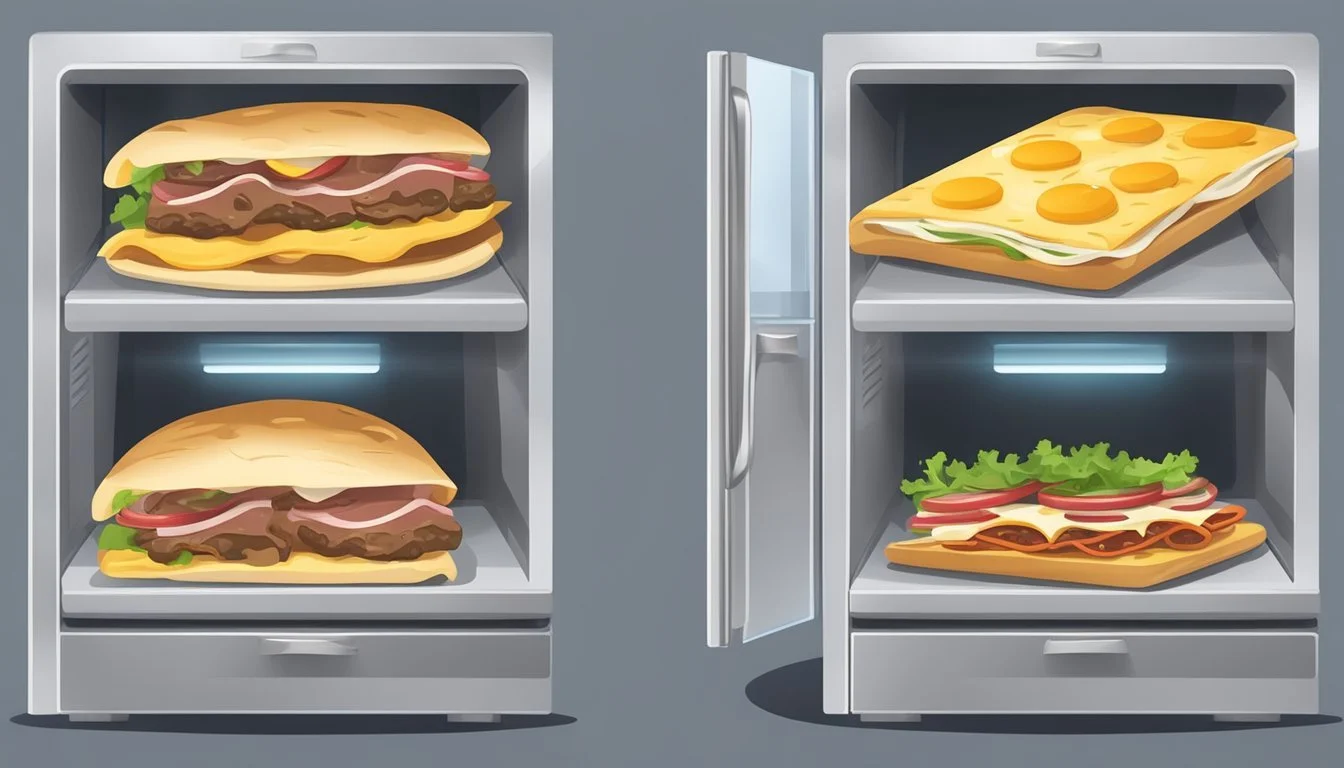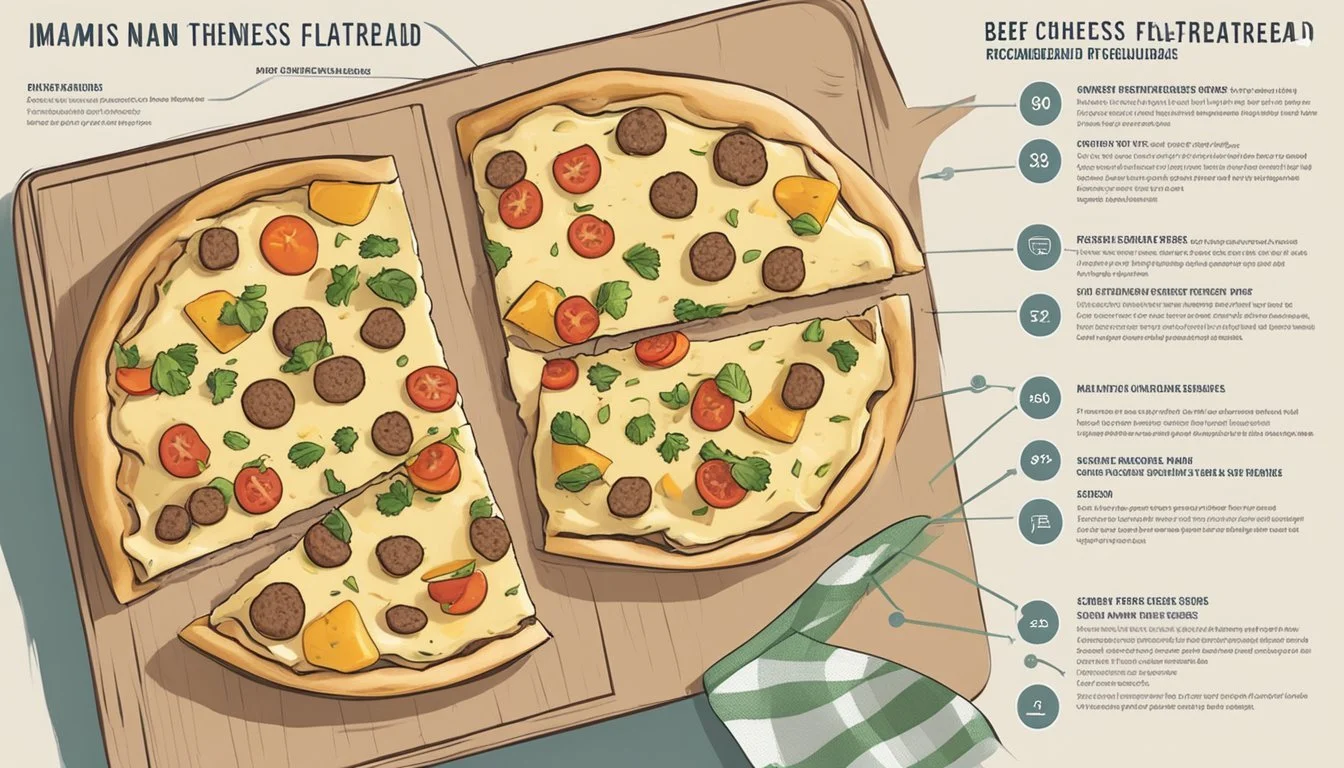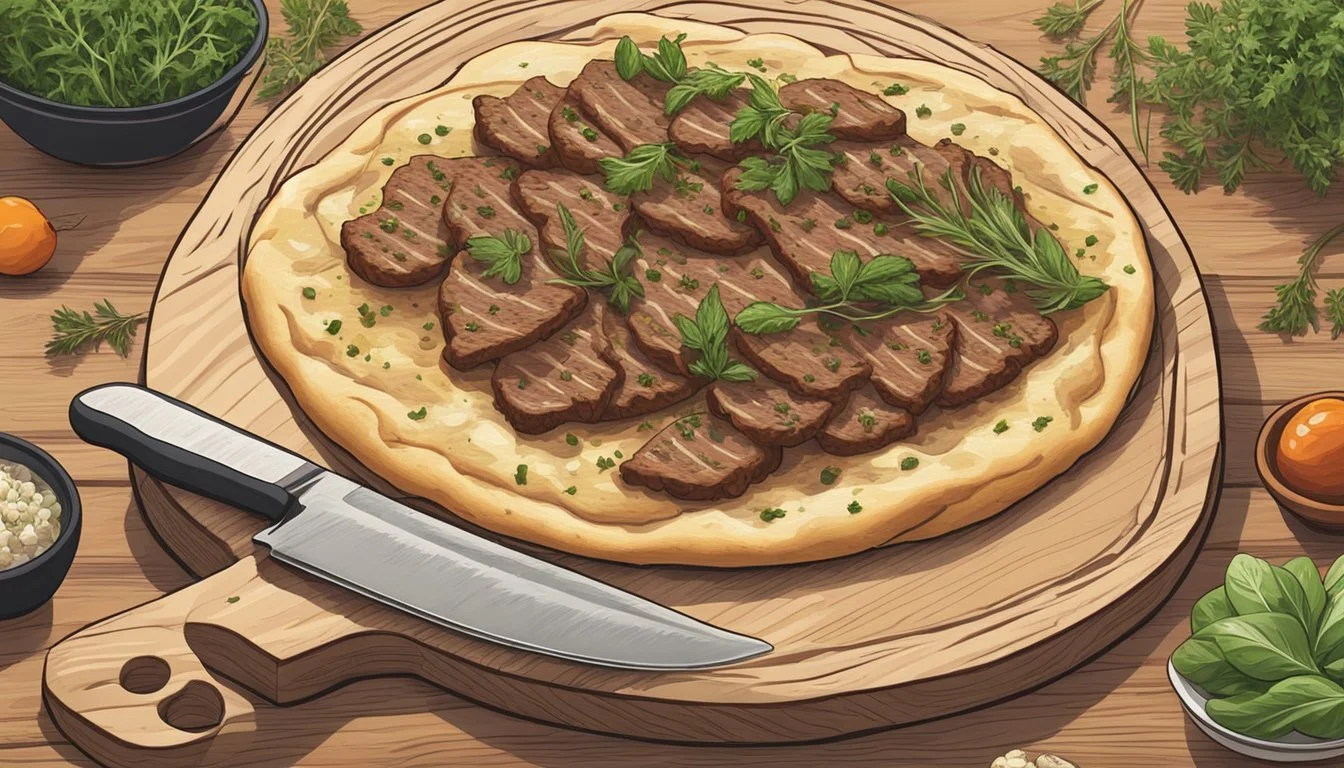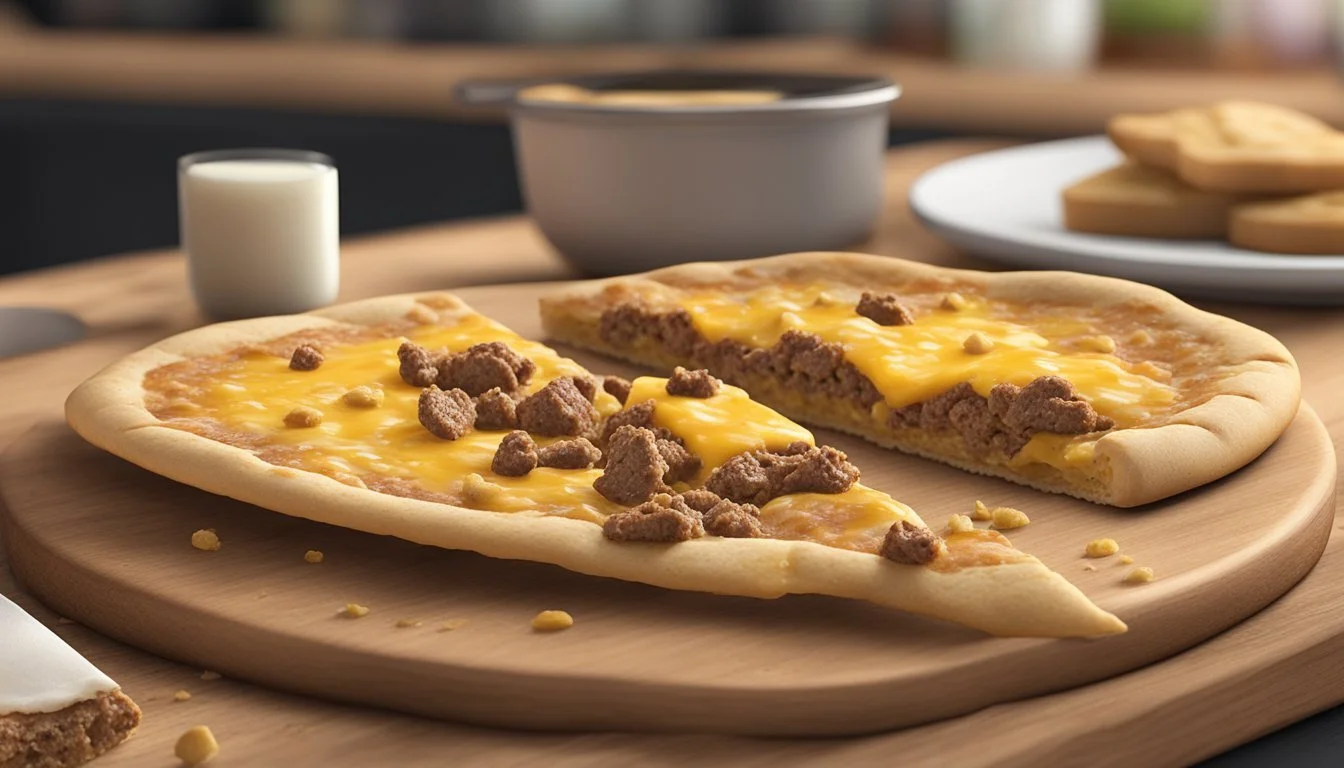How Long Does Beef and Cheese Flatbread Last?
Storage Tips for Freshness
Beef and cheese flatbreads can be a delicious and convenient meal option, but it’s important to know how long they last to ensure food safety and optimal taste. Generally, beef and cheese flatbreads can last up to 3-4 days in the refrigerator if stored properly in an airtight container. This helps maintain their freshness and prevent any potential bacterial growth.
If you’re looking to extend their shelf life, consider freezing them. Properly wrapped in plastic wrap and stored in a freezer-safe bag or container, they can last up to 2 months. Defrosting and reheating them in the oven can help retain their original texture and flavor.
When deciding how long to keep these flatbreads, always look out for signs of spoilage like any unusual smells, mold, or changes in texture. Safety and quality should always be your top priority, ensuring every bite is as enjoyable as the first.
Understanding Beef and Cheese Flatbread
Beef and cheese flatbread is a delightful meal that combines a variety of ingredients harmoniously. Below, details on the flatbread, its key ingredients, and its nutritional profile are explored.
What Is Flatbread
Flatbread is a type of bread characterized by its thin, flat nature, which is baked and not leavened with yeast. Flatbread recipes are diverse and can include ingredients like cheese, garlic, and various seasonings. It serves as a versatile base that can be topped with numerous items such as meats, vegetables, and different types of cheeses, making it an easy meal for various occasions.
Flatbreads can be cooked quickly at high temperatures, typically ranging from 450°F (230°C) to 500°F (260°C). Their evolution dates back to ancient times, with variations found in many cultures across the world.
Key Ingredients
1. Beef: Usually, steak or ground beef is utilized. It should be cooked beforehand, often seasoned with spices like salt and pepper.
2. Cheese: Common choices include parmesan cheese or cottage cheese, which add both flavor and texture. Cheese not only enhances the taste but also boosts the protein content.
3. Flatbread Base: The base is often plain or seasoned with ingredients like olive oil and garlic. Pre-cooking the base can involve brushing it with an olive oil mixture.
4. Vegetables: Ingredients like onions, bell peppers, and tomatoes are frequently included. These can be sautéed to bring out their flavors.
Nutritional Profile
A beef and cheese flatbread provides a balanced nutrient intake. It is typically high in protein, thanks to the beef and cheese. Depending on the recipe, the calorie content can vary, but an average serving often contains around 300-500 calories.
Nutritional Elements:
Proteins: From beef and cheese, essential for muscle repair and growth.
Fats: Primarily from cheese and olive oil, provide energy and support cell function.
Carbohydrates: Supplied by the flatbread base, crucial for energy.
Including vegetables ensures additional vitamins and minerals, enhancing the nutritional value of the flatbread. This makes it not only a satisfying meal but also one that can support a balanced diet.
Preparation Techniques
Preparation techniques for beef and cheese flatbread are crucial to achieve a delightful flavor and texture. These techniques encompass baking essentials, various cooking methods, ingredient variations, and useful recipe tips.
Baking Essentials
When preparing beef and cheese flatbread, the choice of ingredients and equipment can significantly impact the outcome. Essential items include high-quality flour, yeast, olive oil, and seasonings such as garlic powder, black pepper, and rosemary.
A baking sheet is often required, lightly greased to prevent sticking. It's also important to preheat the oven to achieve an even cook. For most flatbreads, preheating the oven to 450°F (230°C) provides a perfect balance of crispness and tenderness. Ensuring consistent dough consistency is vital—it should be smooth and slightly elastic.
Cooking Methods
There are several cooking methods to consider, each adding a unique touch to the flatbread. One popular option is using an oven. Preheating the oven to the recommended temperature and baking the flatbread for about 8-10 minutes ensures thorough cooking. Using a baking sheet lined with parchment paper prevents sticking and simplifies cleanup.
Another method involves using an air fryer. This appliance can cook the flatbread at a lower temperature, around 375°F (190°C), for a shorter cook time of approximately 5-7 minutes.
Stovetop grilling is also an option where the flatbread is cooked on a hot griddle, flipping once to ensure even browning.
Ingredient Variations
Experimenting with ingredients allows for various flavor combinations. Traditional recipes often feature steak bites and cheese, but additional toppings can enhance the dish. For a fresh touch, spinach leaves, grape tomatoes, and red onions are excellent options.
Seasonings such as Italian seasoning, oregano, and black pepper provide depth and complexity. For a cheesy experience, variations like adding mozzarella or parmesan can be considered.
Don't forget to spread a delicious mixture of olive oil and minced garlic over the flatbread before baking to elevate its aromatic profile.
Recipe Tips
To ensure the optimal result, follow a few tips. Use fresh ingredients to guarantee the best flavors. A kitchen brush can help evenly spread the olive oil and garlic mixture over the flatbread.
Make sure to cut ingredients like tomatoes and onions uniformly to ensure even cooking. Balancing amounts is essential; too much topping can prevent the flatbread from achieving the desired crispness.
For a gourmet touch, consider using a combination of cheeses and sprinkling some fresh herbs after cooking. Use airtight containers to store any leftovers to maintain freshness.
By following these preparation techniques, you’ll create a delicious and well-textured beef and cheese flatbread every time.
Storage Guidelines
For optimal longevity and quality, proper storage of beef and cheese flatbread is crucial. Detailed instructions and practical tips will help maintain freshness and safety.
Proper Storage Conditions
Store cooked flatbread and all its ingredients in an airtight container to prevent moisture loss and contamination. Place the container in a cool area, ideally in the refrigerator at a temperature below 40°F (4°C). If you have alternative kitchen storage options such as a pantry, it's best to avoid these for flatbread with perishable toppings like beef and cheese.
Always ensure that your refrigerator is clean to avoid cross-contamination. Keeping the storage environment hygienic will extend the freshness of your flatbread.
Shelf Life Information
Refrigerated beef and cheese flatbread can last for up to 3-4 days. Beyond this period, the risk of spoilage and foodborne illness increases significantly. It's important to note that plain flatbread without any toppings can last longer, typically up to a week when stored properly.
For more extended storage, consider freezing the flatbread. Be mindful of the shelf life variations depending on the ingredients used. Ground beef, for instance, needs more frequent monitoring due to its shorter freshness period compared to other cuts of beef.
Freezing and Thawing
To freeze, wrap the flatbread tightly in plastic wrap or foil and place it in an airtight container or freezer bag. This prevents freezer burn and helps retain the flatbread's quality. Properly stored, it can last up to 2-3 months in the freezer.
When ready to eat, thaw the flatbread in the refrigerator overnight. For a quicker alternative, use the microwave's defrost setting. Ensure that you reheat the flatbread until it's evenly hot to eliminate any potential bacteria.
Signs of Spoilage
Several indicators can help you identify spoiled beef and cheese flatbread. Check for mold growth, which appears as discolored patches on the flatbread surface. An off odor, especially sour or rancid smells, is another clear sign of spoilage.
Inspect the beef for any change in texture or color, such as a greyish hue, which signifies it's gone bad. Additionally, if the flatbread feels excessively slimy or sticky, it's best to discard it.
Food Safety Tips
Always handle beef and cheese flatbread with clean hands and utensils to prevent cross-contamination. Regularly check the internal temperature of the beef using a food thermometer; cooked beef should reach at least 160°F (71°C) for safety.
Consider portioning the flatbread into smaller servings before storing. This not only makes it easier to thaw and reheat but also helps maintain quality. Follow storage guidelines strictly to ensure your food remains safe to eat and retain its best taste.
Serving Suggestions
Beef and cheese flatbread can be enhanced with several accompaniments and toppings to create a well-rounded meal. Including sides and selecting the perfect toppings can elevate the experience, providing both variety and balance.
Accompaniments and Side Dishes
Pairing beef and cheese flatbread with fresh salads or grilled vegetables adds a healthy, vibrant contrast. A Caesar salad or a simple arugula salad with lemon vinaigrette can work well. Roasted veggies like bell peppers, zucchini, and cherry tomatoes match the robust flavors of the flatbread.
Soup is another excellent accompaniment. Options like tomato basil soup or butternut squash soup can provide a comforting, warm side dish. For those seeking a lighter option, cucumber yogurt dip served with veggie sticks offers a refreshing counterbalance.
For variety, offer a selection of dipping sauces, such as garlic aioli or spicy sriracha mayo, adding an extra layer of flavor to each bite.
Flatbread Toppings
Customizing the flatbread with a range of delicious toppings can suit different preferences. Add mozzarella cheese, shredded cheese, or cheddar cheese for a rich, melty texture. Veggies like spinach, caramelized onions, and mushrooms add nutrients and enhance taste.
Incorporate meat toppings like thinly sliced ham or turkey breast to complement the beef. To further enrich the dish, sprinkle on fresh herbs such as cilantro or parsley after baking.
Sauce options such as a drizzle of balsamic reduction or a swirl of spicy barbecue sauce can add depth and a burst of flavor. These toppings, combined with the beef and cheese, create a versatile and satisfying meal.
Dietary Adaptations
Enjoying beef and cheese flatbread can fit into various dietary lifestyles with some adaptations. Whether catering to gluten-free or vegetarian diets, there are practical substitutions to consider.
Gluten-Free Options
To make a beef and cheese flatbread gluten-free, choose alternative flours like almond or coconut flour. These flours provide a low-carb and nutrient-rich base. Almond flour offers a subtle, nutty flavor and is high in protein and healthy fats. Coconut flour, on the other hand, adds a slight sweetness and is high in fiber.
For toppings, ensure any sauces or seasonings are gluten-free. Pre-packaged mixes often contain hidden gluten, so it's best to use fresh herbs and spices.
Cheeses are naturally gluten-free, but always check labels to avoid additives. Additionally, consider using gluten-free beef products if buying pre-cooked or processed options.
Vegetarian Variants
For a vegetarian-friendly option, omit the beef and focus on delicious, plant-based toppings. Hummus can serve as a creamy and flavorful base instead of traditional spreads. Add a variety of vegetables such as avocado, bell peppers, spinach, and tomatoes for added texture and nutrients.
Use a mix of cheeses, like mozzarella and cheddar, to maintain the cheesy, gooey appeal. Incorporating plant-based meats or tofu can also add protein without sacrificing taste.
Sprinkle the flatbread with seasonings, such as garlic powder, Italian herbs, or chili flakes, to enhance the flavor further. These vegetarian variants ensure that the dish remains satisfying and nutritious while adhering to a meat-free diet.
Alternative Uses
Beef and cheese flatbread offers a versatile base for several culinary creations, turning leftovers into delicious new meals. Using this flatbread, you can easily create quick snacks or full meals, making it a handy option for various occasions.
Flatbread Pizza
Transforming beef and cheese flatbread into a flatbread pizza is a simple yet tasty choice. Just add your favorite pizza toppings such as pepperoni, vegetables, and additional cheese on top. Bake in a preheated oven at 375°F until the toppings are bubbling and the edges are crispy. This method is perfect for a quick lunch or a weeknight dinner, offering both convenience and flavor.
Wraps and Sandwiches
Using the flatbread as a base for wraps and sandwiches provides a practical way to enjoy a filling meal. Lay the flatbread flat, spread some hummus or a favorite sauce, and layer with fresh vegetables, leftover beef, and cheese slices. Roll it up tightly or fold into a sandwich. This is a fantastic lunch option that can be made in advance and is easy to carry for meals on the go.
Creative Leftovers
For a more innovative use, repurpose the beef and cheese flatbread into creative leftovers. Cut the flatbread into small bite-sized pieces and serve with dips like guacamole or salsa for an appetizer. Alternatively, mix pieces of the flatbread into a salad, adding a unique texture and flavor. These methods not only reduce food waste but also provide appealing snacks and meal components that are different and delightful.
Enhancing Flavors and Textures
For an elevated taste experience, consider incorporating specific seasoning mixes into the beef and cheese flatbread to achieve a golden brown finish, a crispy texture, and enhanced flavors.
Seasoning Mixes
To enrich the overall taste, blend cottage cheese with garlic powder, Italian seasoning, salt, and pepper before spreading it onto the flatbread.
When baking, the seasonings meld together to create a savory, complex palate that complements the cheese's creamy texture. Fresh herbs like basil or parsley can be added after baking to preserve their fresh flavor and add a touch of green vibrancy.
A dash of paprika or chili flakes can enhance the flatbread with subtle heat, making each bite not only flavorful but also more interesting in texture and look.
Tools and Equipment
To prepare a delicious and long-lasting beef and cheese flatbread, having the right tools and equipment is crucial. This section covers the essential kitchen gadgets and utensils that will make the cooking process easier and more efficient.
Kitchen Gadgets
Blender or Food Processor: A blender or food processor is essential for creating smooth and consistent mixtures, such as dough or sauces. For example, blending cottage cheese, eggs, and seasonings creates a smooth base for low-carb flatbread.
Grill or Toaster: A grill or toaster helps achieve a crispy texture on the flatbread. Reheating in a grill gives the flatbread a golden brown, crispy finish while maintaining its fresh flavor.
Steamers: Using a steamer can revive stale flatbread, making it soft and pliable again. Wrapping the flatbread in a damp kitchen towel and steaming it for a few minutes can significantly improve its texture.
Utensils and Bakeware
Baking Sheet with Parchment Paper: A baking sheet lined with parchment paper is perfect for baking flatbreads. The parchment prevents sticking and ensures even baking.
Pastry Brush: A pastry brush is useful for spreading olive oil or butter evenly over the flatbread. This ensures that toppings like spinach, tomatoes, and steak bites stay in place and are evenly flavored.
Aluminum Foil: Aluminum foil can be used to cover flatbread while baking to avoid over-browning. It is also helpful for wrapping flatbread for reheating purposes.
Damp Kitchen Towel: Useful in the steaming process to soften stale flatbread. Wrapping the flatbread in this towel before placing it in a steamer ensures an improved texture and softness.
Using these tools and equipment will ensure that your beef and cheese flatbread is not only delicious but also has a longer shelf life, whether you store it in the refrigerator or reheat it for a later meal.
Frequently Asked Questions
How long does beef and cheese flatbread last in the refrigerator?
Beef and cheese flatbread can last up to 3-4 days in the refrigerator if stored properly in an airtight container or tightly wrapped in plastic.
Can beef and cheese flatbread be frozen?
Yes, it can be frozen. Wrap it tightly in aluminum foil or place it in a resealable freezer bag. It can last up to 2 months in the freezer.
How should beef and cheese flatbread be reheated?
Preheat the oven to 350°F (180°C). Place the flatbread on a baking sheet and heat for about 10-15 minutes or until warmed through. Alternatively, you can reheat it on a skillet over medium-high heat for 2-3 minutes on each side.
Does the type of bread affect the storage time?
Yes, the type of bread matters. Flatbread generally has a slightly longer shelf life compared to other types of bread if stored correctly.
How can you tell if the flatbread has gone bad?
Signs of spoilage include an off smell, visible mold, and a change in texture. If the bread has any unusual color or odor, it is best to discard it.
What are the best storage practices for beef and cheese flatbread?
Store the flatbread in an airtight container or wrap it tightly in plastic wrap. Refrigerate it promptly to extend its shelf life and maintain quality.
Can the ingredients affect how long the flatbread lasts?
Yes, ingredients like preservatives in the bread or the freshness of the beef and cheese can impact how long the flatbread remains safe to eat.
Is it safe to eat flatbread past its expiration date?
If stored properly and there are no signs of spoilage, it may be safe to eat a few days past the expiration date. Always check for signs of spoilage first.











